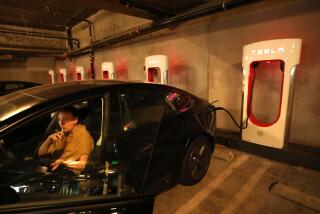300 M.P.G. Is Not Out of the Question : All the technology for a fuel-efficient ‘supercar’ is in use now, but it will take a new mind-set to bring it together.
A year ago, with considerable fanfare, President Clinton entered into an agreement with the Big Three U.S. auto makers to develop within 10 years cars that can double or triple the 30 miles per gallon that the average new American car gets now.
In fact, many auto companies have had for years demonstration models that get 60 to 100 miles to the gallon. I used to listen with amazement when engineers claimed they could get 120 to 130 m.p.g. Then my friend Amory Lovins, the energy-efficiency guru of Rocky Mountain Institute, turned his attention from saving electricity to saving gas. He started talking about 150 miles per gallon. That number crept up to 200. Now he’s confident of 300 m.p.g., he’s done calculations that yield 600, and on his expansive days, he stuns his own staff by mentioning 1,000.
And he’s not talking puny jazzed-up bicycles or high-tech jewels made of rare metals. He’s talking safe, peppy, comfortable, quiet, beautiful, affordable family cars. They are, however, a wholly different kind of car. In today’s most efficient cars, only 15% to 20% of the energy in the gas gets to the wheels. Only about 2% actually moves the driver; the rest hauls the ton of metal around the driver. Because of that ton of metal, engines have to be enormous. The key to the “supercar” is to make it much lighter and much more aerodynamic, which would then allow it to have a much smaller, more efficient engine.
The lightness comes from getting rid of the steel. The supercar will be made of composite materials--carbon-fiber, fiberglass and plastic specially designed to absorb far more crash energy per pound than metal. You’ve watched these materials at work if you’ve ever seen an Indy-500 driver hit a wall at 200 m.p.h. and walk away. Race cars are made of carbon-fiber. This material can be reclaimed and recycled and it doesn’t rust.
Lovins estimates that cars could be made two to six times as slippery as they are now (in terms of energy lost to air drag) by, for instance, reducing the frontal area and making the underside as smooth as the top. A lighter, sleeker car can have a lighter suspension and needs to carry less fuel. It puts less weight on the tires, so it loses less energy to road friction.
The supercar engine will be “hybrid-electric.” The hybrid-electric car will carry fuel to make its own electricity on board. It will recapture about 70% of the energy lost in braking by using a small battery or a flywheel, which can deliver extra push for acceleration and hill-climbing. Says Lovins, “With its power so boosted, the engine needs to handle only the average load, not the peak load, so it can shrink to about one-tenth the normal size. It would run very near its optimal point, doubling its efficiency, and turn off whenever it’s not needed.”
Such an engine could run on any fuel, from gasoline or natural gas to solar-generated hydrogen. Except for that last bit about hydrogen, none of these ideas --composite body, advanced aerodynamics, hybrid-electric engine--is impossibly futuristic. Each one is already in use somewhere. What’s new is putting them together to reap their reinforcing benefits.
The combination will revolutionize the automobile industry. Lovins envisions assembly plants that mold lightweight, easy-to-handle car pieces, combining in one step 10 to 100 parts that now have to be pounded out of steel and welded together. The pieces wouldn’t have to be painted because the color could be added in the mold. The molds would be simpler and far less expensive than tool-steel dies. It would take weeks or months, not years, to change a design. Factories could be small and widely distributed.
Lovins imagines buying a car the way he now buys a home computer, out of a catalogue, or after a demonstration of the options, making his choice and having the car delivered to his door two days later, freshly turned out in a local plant.
If you think the purpose of life is to maximize the gross national product, you might see the supercar as a disaster. It would certainly downsize the car-making, petroleum and steel industries. If, however, you understand that the GNP is the cost we pay to lead life, you’ll rejoice. There can be nothing wrong with using less oil and steel, generating less pollution, mining and drilling less wilderness, transporting less material, being less dependent on imports, and not having to defend the Persian Gulf.
No new technology solves every problem. Supercars won’t unclog traffic jams or reduce the need to cover the land with asphalt. If that’s what we want, we’ll have to do even more advanced thinking.






